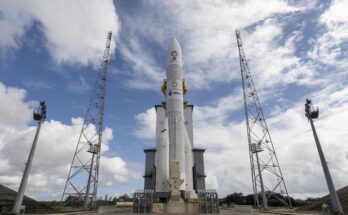by Bill Ostrove, Space Systems Analyst, Forecast International.
The remote sensing satellite market is growing rapidly, and it remains to be seen whether a recent trend toward larger satellites will continue.
Forecast International recorded the launch of 63 civil and commercial remote sensing satellites between 2010 and 2014. Launch rates held steady at between nine and 13 per year from 2010 to 2013; however, in 2014, launches spiked to 20. This increase corresponds with a higher satellite delivery rate, which is partially due to a number of programs – such as Europe’s Copernicus – reaching the production phase. Commercial satellite deliveries have also increased. Deimos-2, WorldView-3, SkySat-2, and SPOT 7 were all delivered in 2014. As the number of commercial remote sensing satellite operators increases, commercial deliveries will account for a larger share of overall deliveries.
 While the launch mass of remote sensing satellites has fluctuated from year to year, there has been a general upward trend. The average launch mass in 2010 was 1,419 kilograms. That figure decreased to 1,111 kilograms in 2011. However, it increased in both 2012 and 2013 to 1,812 kilograms and 1,971 kilograms, respectively. Launch mass then dropped slightly in 2014 to 1,754 kilograms.
While the launch mass of remote sensing satellites has fluctuated from year to year, there has been a general upward trend. The average launch mass in 2010 was 1,419 kilograms. That figure decreased to 1,111 kilograms in 2011. However, it increased in both 2012 and 2013 to 1,812 kilograms and 1,971 kilograms, respectively. Launch mass then dropped slightly in 2014 to 1,754 kilograms.
Despite the recent trend toward larger satellites, small satellites – with a launch mass below 200 kilograms – are becoming increasingly popular (for example, Skybox Imaging recently ordered thirteen 140-kilogram satellites from Space Systems/Loral), and small satellite operators continue to pop up.
Previously, small satellites were primarily used for technology development and short-duration scientific missions; however, they are increasing in popularity. The benefits of small satellites include reduced launch costs and increased global coverage. Since they are smaller and cheaper, losing a satellite during a launch failure will not result in a huge financial loss. The short build time also allows companies to rapidly develop new capabilities. Small satellites could, therefore, begin to increase in importance in the future. Planet Labs is one example of a company that has plans to use small satellites to sell imagery to customers.
Alternatively, the market could become generally more diverse. Large satellites are better equipped to provide high-resolution images, while small satellites are much cheaper to build and launch. Different size satellites will be used for different purposes, with a place in the market for small, medium, and large varieties. In other words, large satellite operators like DigitalGlobe will provide complementary services to small satellite firms like Planet Labs.
For more information, please see Forecast International’s Civil & Commercial Remote Sensing Analysis.
A military history enthusiast, Richard began at Forecast International as editor of the World Weapons Weekly newsletter. As the Internet grew in importance as a research tool, he helped design the company's Forecast Intelligence Center and currently coordinates the EMarket Alert newsletters for clients. Richard also manages social media efforts, including two new blogs: Defense & Security Monitor, covering defense systems and international issues, and Flight Plan, which focuses on commercial aviation and space systems. For over 30 years, Richard has authored the Defense & Aerospace Companies, Volume I (North America) and Volume II (International) services. The two books provide detailed data on major aerospace and defense contractors. He also edits the International Contractors service, a database that tracks all the contractors involved in the programs covered in the FI library. More recently he was appointed Manager, Information Services Group (ISG), a new unit that encompasses developing outbound content for both Forecast International and Military Periscope.



